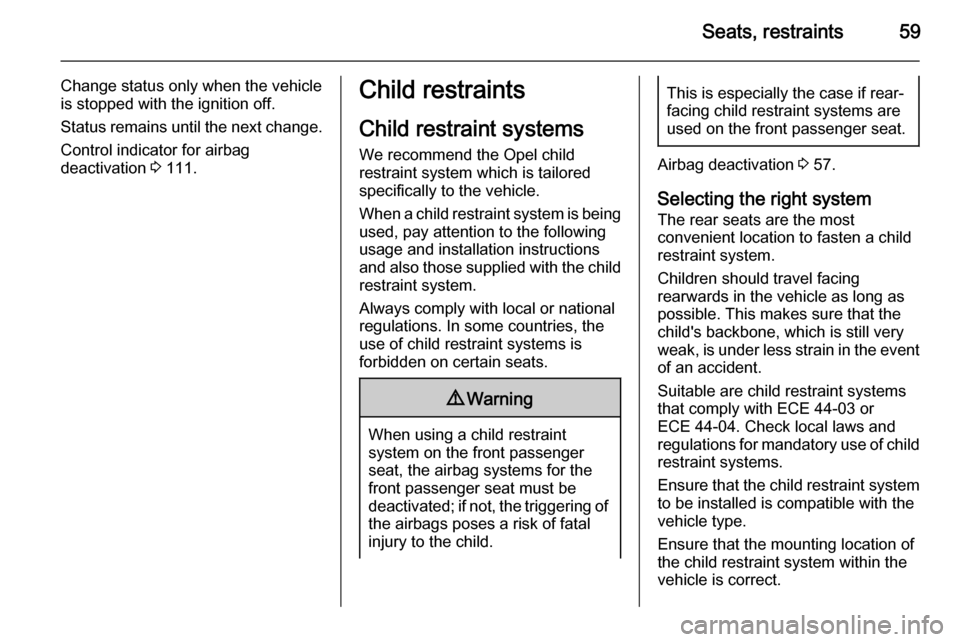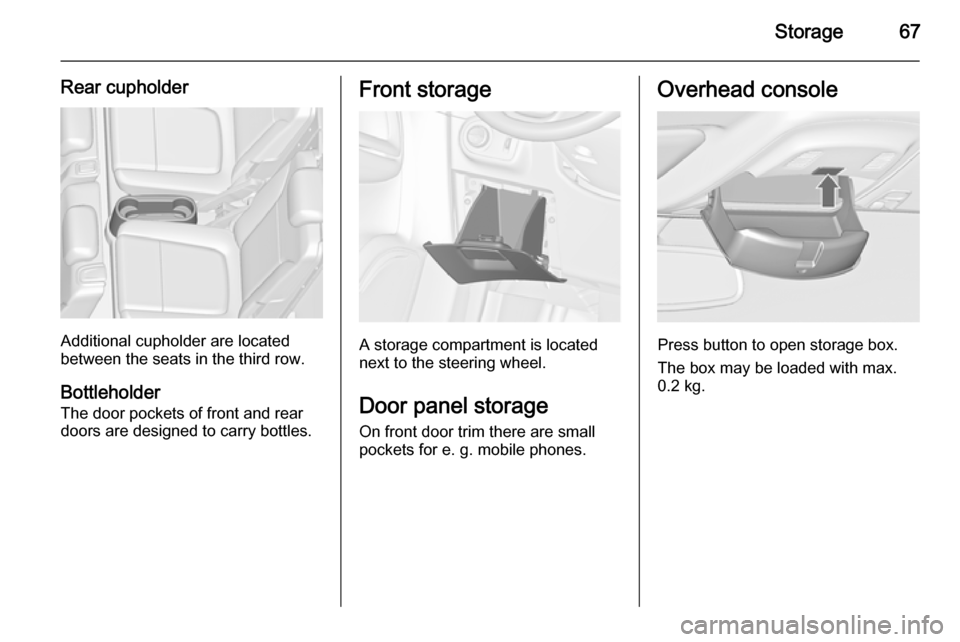OPEL ZAFIRA C 2014 Manual user
Manufacturer: OPEL, Model Year: 2014, Model line: ZAFIRA C, Model: OPEL ZAFIRA C 2014Pages: 299, PDF Size: 9.03 MB
Page 61 of 299

Seats, restraints59
Change status only when the vehicle
is stopped with the ignition off.
Status remains until the next change.
Control indicator for airbag
deactivation 3 111.Child restraints
Child restraint systems We recommend the Opel child
restraint system which is tailored
specifically to the vehicle.
When a child restraint system is being
used, pay attention to the following
usage and installation instructions
and also those supplied with the child restraint system.
Always comply with local or national
regulations. In some countries, the
use of child restraint systems is
forbidden on certain seats.9 Warning
When using a child restraint
system on the front passenger
seat, the airbag systems for the
front passenger seat must be
deactivated; if not, the triggering of the airbags poses a risk of fatal
injury to the child.
This is especially the case if rear-
facing child restraint systems are
used on the front passenger seat.
Airbag deactivation 3 57.
Selecting the right system The rear seats are the most
convenient location to fasten a child restraint system.
Children should travel facing
rearwards in the vehicle as long as
possible. This makes sure that the child's backbone, which is still very
weak, is under less strain in the event of an accident.
Suitable are child restraint systems
that comply with ECE 44-03 or
ECE 44-04. Check local laws and
regulations for mandatory use of child
restraint systems.
Ensure that the child restraint system to be installed is compatible with the
vehicle type.
Ensure that the mounting location of
the child restraint system within the
vehicle is correct.
Page 62 of 299

60Seats, restraints
Allow children to enter and exit the
vehicle only on the side facing away
from the traffic.
When the child restraint system is not in use, secure the seat with a seat beltor remove it from the vehicle.
Note
Do not affix anything on the child
restraint systems and do not cover
them with any other materials.
A child restraint system which has
been subjected to stress in an
accident must be replaced.
Page 63 of 299

Seats, restraints61Child restraint installation locationsPermissible options for fitting a child restraint system
Weight and age class
On front passenger seatOn outboard seats in the second rowOn centre seat in
the second rowOn seats in the third rowactivated airbagdeactivated airbagGroup 0: up to 10 kg
or approx. 10 monthsXU 1U2XUGroup 0+: up to 13 kg
or approx. 2 yearsXU 1U2XUGroup I: 9 to 18 kg
or approx. 8 months to 4 yearsXU 1U2XUGroup II: 15 to 25 kg
or approx. 3 to 7 yearsXXUXUGroup III: 22 to 36 kg
or approx. 6 to 12 yearsXXUXU1=Only if front passenger seat airbag system is deactivated. If the child restraint system is being secured using a three- point seat belt, move seat height adjustment to uppermost position and ensure that vehicle safety belt runs forwards
from the upper anchorage point. Adjust seat backrest inclination as far as necessary to a vertical position to ensure
that the belt is tight on the buckle side.2=Seat available with ISOFIX and Top-Tether mounting brackets 3 64.U=Universal suitability in conjunction with three-point seat belt.X=No child restraint system permitted in this weight class.
Page 64 of 299

62Seats, restraints
Permissible options for fitting an ISOFIX child restraint systemWeight classSize classFixtureOn front passenger
seatOn outboard seats
in the second rowOn centre seat in
the second rowOn the seats in
the third rowGroup 0: up to 10 kgEISO/R1XILXXGroup 0+: up to 13 kgEISO/R1XILXXDISO/R2XILXXCISO/R3XILXXGroup I: 9 to 18 kgDISO/R2XILXXCISO/R3XILXXBISO/F2XIL, IUFXXB1ISO/F2XXIL, IUFXXAISO/F3XIL, IUFXXIL=Suitable for particular ISOFIX restraint systems of the 'specific-vehicle', 'restricted' or 'semi-universal' categories.
The ISOFIX restraint system must be approved for the specific vehicle type.IUF=Suitable for ISOFIX forward-facing child restraint systems of universal category approved for use in this weight class.X=No ISOFIX child restraint system approved in this weight class.
Page 65 of 299

Seats, restraints63
ISOFIX size class and seat deviceA – ISO/F3=Forward-facing child restraint system for children of maximum size in the weight class 9 to 18 kg.B – ISO/F2=Forward-facing child restraint system for smaller children in the weight class 9 to 18 kg.B1 – ISO/F2X=Forward-facing child restraint system for smaller children in the weight class 9 to 18 kg.C – ISO/R3=Rear-facing child restraint system for children of maximum size in the weight class up to 18 kg.D – ISO/R2=Rear-facing child restraint system for smaller children in the weight class up to 18 kg.E – ISO/R1=Rear-facing child restraint system for young children in the weight class up to 13 kg.
Page 66 of 299

64Seats, restraintsISOFIX child restraint
systems
Fasten vehicle-approved ISOFIX
child restraint systems to the ISOFIX
mounting brackets. Specific vehicle
ISOFIX child restraint system
positions are marked in the table by
IL.
ISOFIX mounting brackets are
indicated by a label on the backrest.
Before fastening a child seat adjust
the head restraint to use position
3 37.
When using ISOFIX fastened child
restraint systems on the second seat
row, we recommend to adjust the
accordant outer seat in third notch
from rear end position, regarding to
base seats. Lounge seat, if equipped, must be in normal position 3 45.
Top-tether fastening eyes
Top-Tether fastening eyes are
marked with the symbol : for a child
seat.Depending on country-specific
equipment, the vehicle may have two or three fastening eyes.
In addition to the ISOFIX mounting,
fasten the Top-Tether strap to the
Top-Tether fastening eyes. The strap
must run between the two guide rods
of the head restraint.
ISOFIX child restraint systems of
universal category positions are
marked in the table by IUF.
Page 67 of 299

Storage65StorageStorage compartments................65
Load compartment .......................78
Roof rack system .........................93
Loading information .....................94Storage compartments9Warning
Do not store heavy or sharp
objects in the storage
compartments. Otherwise, the
storage compartment lid could
open and vehicle occupants could be injured by objects being thrown
around in the event of hard
braking, a sudden change in
direction or an accident.
Instrument panel storage
In the instrument panel in front of the
Info-Display is a storage
compartment. Push to open the lid.
Glovebox
There are two gloveboxes on the
passenger side.
To open the upper glovebox, press
button on the left side in the open
storage.
To open the lower glovebox, pull the
handle.
The gloveboxes should be closed
whilst driving.
Page 68 of 299

66StorageCupholders
Front cupholder
Cupholders are located in the centre
console between the front seats.
Slidable cupholder in
FlexConsole armrest
The cupholder can be moved in guide rails in the FlexConsole armrest or
completely removed.
Push the handle in front of cupholder
to slide.
Armrest 3 44.
Remove cupholder
Pull the handle in front of cupholder
and remove it vertically out of the
console.
Installation in reverse order.
Note
Install the cupholder in the direction as shown in the illustration.
Otherwise the cupholder may not engage properly.
Page 69 of 299

Storage67
Rear cupholder
Additional cupholder are located
between the seats in the third row.
Bottleholder
The door pockets of front and rear
doors are designed to carry bottles.
Front storage
A storage compartment is located
next to the steering wheel.
Door panel storage On front door trim there are small
pockets for e. g. mobile phones.
Overhead console
Press button to open storage box.
The box may be loaded with max.
0.2 kg.
Page 70 of 299

68StorageUnderseat storage
Storage box
There is a storage box under the
passenger's seat. Slide the rollo to
open or close the box. Maximum load: 1.5 kg.
Underseat drawer
Press button in the recess and pull out
drawer. Maximum load: 3 kg. To
close, push in and engage.
Armrest storage
Storage in base armrest
The armrest console contains a
storage compartment. To open, slide armrest forwards.